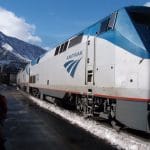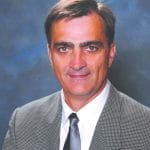
Tag: Acela

The Department of Transportation grant will be used by Amtrak to improve track, signals and overhead catenary, allowing an increase of top speed from 135 mph to 160 mph for Acela Express trains over a 24-mile segment in New Jersey. The grant, which includes a “buy America” provision, will also go toward eliminating congestion at a choke point east of New York City.
Amtrak has a 30-year vision to accelerate speed along the entire length of the Northeast Corridor, with maximum speed of 220-mph over a new two-track route that would supplement existing service and create capacity for 80 million passengers annually by 2040.
The project would require some 420 miles of mostly dedicated high-speed track and a $4.7 billion annual investment for at least 25 years. Amtrak President Joseph Boardman says the plan is feasible as a public-private partnership involving 11 Northeast states plus Virginia and the District of Columbia, privately owned freight railroads, and the private sector.
By 2040, Amtrak would offer passengers travel times of 38-minutes between New York and Philadelphia; 84 minutes between New York and Boston; and 96 minutes between New York and Washington.
Facts about the Northeast Corridor:
* On 65 percent of Northeast Corridor track, Amtrak trains can operate at speeds between 110 mph and 150 mph – and is the only rail passenger operator in the United States maintaining track for speeds in excess of 100 mph.
* Between Washington, D.C., and New York, Amtrak has 69 percent of the air-rail market share – up from 37 percent in 2000 when Acela service was introduced. And between New York and Boston, Amtrak has 52 percent of the air-rail market share – up from 20 percent in 2000 when Acela service was introduced
* The Northeast Corridor hosts almost one million intercity and commuter passengers daily on more than 2,000 trains – some 75,000 passengers riding Amtrak daily and more than 850,000 riding commuter trains operated by 18 publicly controlled commuter agencies, making Amtrak a minority user of the Northeast Corridor.
* Amtrak is the only railroad that uses the entire length of the Northeast Corridor.
WASHINGTON — New jobs building and operating high-speed rail “are American jobs that can’t be shipped overseas and would be a Godsend in this economic downturn,” UTU Alternate National Legislative Director John Risch told a congressionally sponsored forum here Aug. 3.
“Railroad operating jobs are not just good paying jobs; they are great careers,” Risch told his audience, which included a bi-partisan group of lawmakers and their staff interested in advancing high-speed passenger railroading, as well as officials of the American High Speed Rail Alliance.
“Amtrak and its workforce should be the backbone for high-speed rail in America,” Risch said. “Amtrak, by law, is America’s national intercity rail passenger network and the nation’s only provider of high-speed rail with its Acela Express service in the Northeast Corridor.”
Risch told the forum the UTU supports Amtrak’s Next Generation Plan for development of high-speed rail in the Northeast Corridor, which would include speeds as fast as 220-mph and significantly reduced travel times.
“Amtrak’s plan would support 44,000 jobs annually over the 25-year construction period and some 120,000 permanent jobs,” Risch said.
“If we were instead to build more highways, we would have to build eight new lanes of Interstate between Washington, D.C., and Boston to accommodate the same number of travelers Amtrak will carry on the Northeast Corridor upon completion of the Next Generation Plan,” Risch said.
“Amtrak,” said Risch, “has extensive experience operating passenger trains in America, has long-standing relationships with the freight railroads and has a proven track-record partnering with state and local governments to provide passenger rail service,” Risch said.
“Most importantly, Amtrak employs the experienced conductors, engineers, on-board service workers, machinists, signalmen, train dispatchers, and others who know how to run a railroad,” Risch said. “These are the best trained passenger-rail workers in the nation, and Amtrak is the best choice to implement any high-speed rail program.”
WILMINGTON, Del. — Amtrak CEO Joseph Boardman, FRA Administrator Joseph Szabo and former BNSF top attorney Jeff Moreland, now an Amtrak board member, were enroute here from Washington Saturday morning for dedication of the new station renamed for Vice President Joe Biden.
They got as far as Baltimore on their first-class passes.
A power problem on the Northeast Corridor stopped all Amtrak trains dependent on the overhead catenary for power.
Fearful they would miss the dedication, they made a call and soon left the train, piling into an automobile quickly provided, and reached Wilmington only a bit late. Biden was patiently awaiting them.
“We would not have gotten off the train if we could have sequenced it faster, but the event would have been over … and that’s the evaluation we made,” Boardman told ABC News.
The news dispatch reported they “were escorted from the coach by security guards and a small entourage of assistants.” ABC News said rental cars were obtained for the entourage.
Biden understood. He said later he had taken more than 7,000 roundtrips between his home in Wilmington and Washington while a U.S. senator; and, yes, not all were on time.
The remaining passengers on the train endured a two-and-a-half hour delay, later attributed to a malfunctioning transformer in Philadelphia.
Boardman used the opportunity to make a pitch for more federal funds for the Northeast Corridor. “If we’re going to really grow the Corridor the way it needs to be grown, we have to substantially increase the amount of power that’s available so that we don’t trip these transformers,” he told ABC News.
